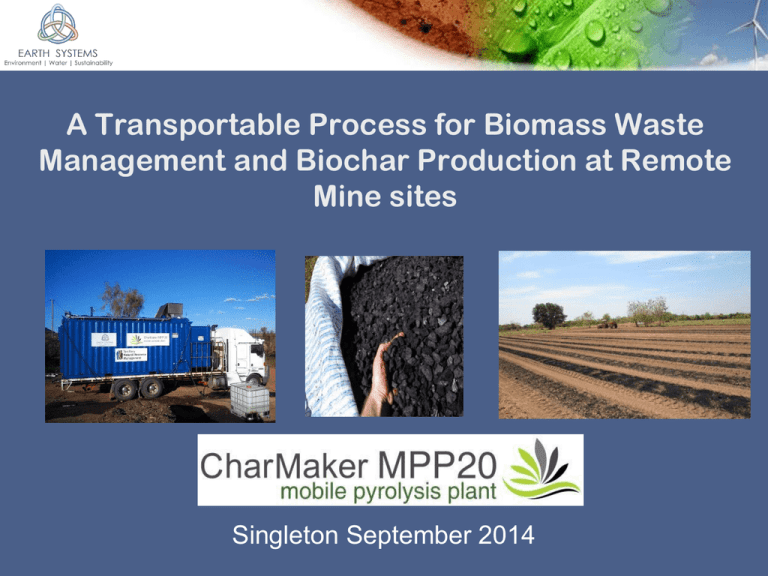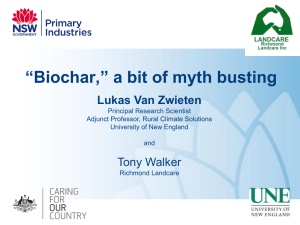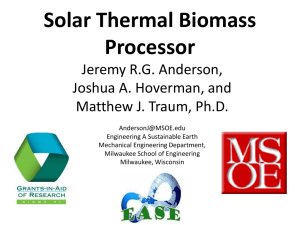200 - Tom Farrell Institute for the Environment
advertisement

A Transportable Process for Biomass Waste Management and Biochar Production at Remote Mine sites Singleton September 2014 About Earth Systems • Established 1993 • ~50 employees in Australia, NZ, Europe, North America, Africa and Asia Earth Systems Service sectors: • • • • Energy and carbon Water management and treatment Environmental impact assessment International aid and development Competitive advantage: • Unique for a small consulting company in that we develop and engineer technical solutions in addition to providing consulting services • Global reach Specialist Expertise • Mining Industry • Ferrous-, Base-, Precious-metals, Coal, Mineral Sands, Uranium, REE • Surface water, Groundwater, Process water. • Water Quality / Water Chemistry / Water Treatment. • Turbidity, salinity, metals, pH, cyanide, nutrients, radioactivity, odour. • Geochemical Engineering. • Acid and Metalliferous Drainage (AMD) • Characterisation, Risk assessment, Management, and Treatment. • Waste Rock, Tailings Storage facilities, Pit Lakes. • Open cut and Underground. • Mine site rehabilitation and closure. www.earthsystems.com.au enviro@earthsystems.com.au MPP20 – Mobile Biochar Production In-field conversion of unchipped wood residues to biochar for agriculture and other uses Biochar Woody waste MPP20 (Residues which would either be burned or rot down) (Stable long term carbon sink which improves soils) What is Biochar? • Terra Preta (“Black earth”) – dark, fertile human-produced soils of the Amazon region with a high char content that have remained fertile for thousands of years. • “Biochar” is the modern equivalent; it is closer to activated carbon than “charcoal” (lower volatiles – higher fixed C) and its addition generally results in improved soil health and better plant growth. • Over the last 10 years, biochar has been gaining increasing worldwide interest for its ability to improve crop yields and sequester atmospheric CO2. http://www.transitionmarlborough.org/blogpost35-What-isbiochar http://blog.holstee.com/post/32199703787/b iochar-the-new-compost Under the Microscope… Biochar Benefits • Improving water and nutrient retention in the soil; • Increasing cation exchange capacity; • Reducing soil acidity; • Increasing soil carbon; • Encouraging the growth of beneficial soil microbes; • Enhancing the effectiveness of fertilizers; • Reduced soil emissions. • Soil Amendment Environmental Applications – Biochar should be applied where it can address a known soil constraint – You can’t just add it and expect improvements in all situations • Biochars with higher mineral ash content tend to improve yields • Biochars with higher carbon content tend to increase soil carbon • Compost and biochar combined together work far better than either compost or biochar alone • Water treatment – Wood based biochars tend to be good at removing organic contaminants from water – Not so good with soluble inorganics • Spill control – Good sorbent for non polar molecules (fuel/oil spills etc) Other Applications • Density modifier – Biochar is finding increasing use as a low density filler in construction materials (eg concrete blends) • Food storage – Biochars absorb ethylene fruit stored with biochar stays fresh longer • Odour control – Products incorporating biochar for applications in toilets, bedding, footwear etc are all in development / early commercial use. • Carbon sequestration – Bio-sequestration of atmospheric CO2 is a side-benefit of biochar production • Stockfeed • Many animals (dogs, chickens, cows monkeys etc) seek out and consume char, which has various digestive benefits Pyrolysis Co-products • Biochar production via pyrolysis can yield other process outputs depending on the system used: • Heat applications are numerous and site specific, but include thermal water treatment (distillation), water heating, power generation, product drying • Bio-oil / pyrolysis oils: a mixture of tarry compounds which can be substituted for heavy fuel oils if dewatered and treated with an appropriate upgrading step. Raw bio-oils are quite toxic and should not be produced without good reason! • Wood vinegars: water, acetic acid, methanol, acetone, various watersoluble organics including phenols. If HEAVILY diluted (200:1), anecdotal evidence indicates benefits in seed germination and pest reduction. Substantial soil applications not generally recommended due to potential accumulation of toxic organics over time. Woody Waste Sources • Vegetation clearing • Pallets and wooden packaging materials MPP20 Charmakers • • • • • • • • Transportable; minimal site preparation requirements No chipping Converts 6 - 9 tonnes biomass per run Run time typically 4 to 5 hours Minimal external fuel usage (<5L diesel per hour) Typical yield 0.8 – 1.6 tonnes biochar per run Ability to capture other by-products (syngas, smokewater) Optional power generation and heat recovery Pyrolysis Process • Bins are filled with feedstock and loaded into MPP20 • Doors are closed and the bins are ignited automatically • Hot gases from the process circulate and pyrolyse the feedstock • Product gases (smoke, volatiles etc) then pass through the afterburner where complete combustion occurs • Significant waste heat is given off during the process; source temperatures as high as 1000 oC are available in the afterburner chamber • The process shuts off automatically at the end of the run, the char is www.earthsystems.com.au quenched and available for removal enviro@earthsystems.com.au Key Characteristics Environmentally friendly: • No “smoke” emissions – useful for urban areas • Mitigate global warming Operational: • Easy to use – operate from smart phone, tablet and Internet explorer on computer • Touch start, then leave to run, then stop and shutdown automatically • Safe to use Minimal fuel requirements – pyrolysis gases run process Practical – no chipping required, designed for smallscale operation Mobility and Feedstocks Feedstocks processed: • Mahogany • Pine • Native pine • Willow • Cottonwood • Poplar • Red, Yellow, White and Blue gum • Grey box • Greenwaste • Invasive native species (INS) • Vines (wine) • Straw • Budda and turpentine • Hemp • Bamboo • Tomato vines waste • Saw mill offcuts • Construction and demolition waste • • • • >10,000 km travelled >20 feedstocks >100 tonnes biochar > 300 tCO2e abated The Biochar Product • Up to 600 m2/gram surface area • ~ 80 to 90% fixed carbon • Highly stable (>1000 years) • High water/nutrient retention • Has shown outstanding results in a variety of agricultural and horticultural applications • Excellent filter material • Now being sold in bulk (to farmers, fertilizer companies and research groups) as well as in 20-30L bags at gardening retailers Novel Aspects of the Technology • Patented pyrolysis technology, developed and owned by Earth Systems • Mobile, fully self contained unit, yet with significant throughput • Much lower setup costs and regulatory hurdles than a fixed plant • Designed to be integrated with existing operator equipment (tractor, loader, excavator etc) • Minimal processing of wood feedstock required (no chipping) • Can be operated or monitored remotely with PC, laptop, tablet or phone • Treatment temperatures and times are adjustable allowing biochar properties to be fine-tuned to different applications. • We have recently tested and proved a modified MPP20 system capable of processing organochlorine (pesticide) contaminated wood into clean char without any harmful emissions Benefits • Woody waste disposal - Cost-effective and environmentally beneficial disposal of waste biomass. Turns a waste management problem into a high value resource • Beneficial product Clean biochar product suitable for soil amendment, stock feed or filtration applications • Energy output A source of high-grade heat for various applications • Carbon sequestration Provides a means for an entity to directly sequester atmospheric CO2 to offset organisational emissions Sequestration Potential • One MPP20, operated full time (250 days per year) can produce around 500 tonnes of biochar per annum, bio-sequestering around 1600 to 2000 tCO2e per annum. • Our estimates suggest there exist at least 50 feasible opportunities for MPP20 deployment in Australia right now, based on waste management scenarios (thus 75 to 100 kt CO2e/annum in commercial applications). Recommendations • Wood-derived biochar has substantial water retention abilities in sandy soils and has tremendous potential in improving the resilience of revegetation species during the early stages of growth. • Adding biochar, or a biochar-based soil amendment beneath plantings as “root bait” is a cost effective way to maximise the impact of the char on plant growth. • The MPP20 Charmaker turns a waste management problem into a high value resource and has a variety of applications right now. • Earth Systems MPP20 units are available for on site use; please contact us to discuss your requirements. Questions? Contact: John Sanderson Principal Environmental Engineer Earth Systems P: 0439654249 E: John.Sanderson@earthsystems.com.au W: www.esenergy.com.au/biochar






